Amazon Web Services offers over 200 services. These include Amazon Elastic Compute Service (ECS), Elastic Kubernetes Service (EKS), and AWS Fargate for deploying and managing containers. Although these popular services share certain similarities, each works in different ways, with unique advantages, limitations, and ideal use cases.
This guide provides a detailed explanation of when to use ECS versus EKS, how Fargate fits in, and how these choices impact cost-efficiency, control, overhead and developer productivity. We will address common points of confusion and delve into the nuanced differences between these services so that you can find the best match for your workloads.
How do you compare ECS vs EKS vs Fargate?
Framing the question as ECS vs EKS vs Fargate might be misleading, since not all three are technically directly comparable.
ECS and EKS are both orchestration services for controlling the deployment and operation of your containers.
The processing power for your containers is delivered by compute services. Within compute services, AWS offers AWS Fargate for serverless computing and Amazon Elastic Compute Cloud (EC2) for more traditional, scalable compute capacity.
So In this guide we will address two common questions we hear:
- When should you use ECS and EKS?
- When should you use Fargate or EC2 with ECS or EKS?
The Container Orchestration Services: ECS and EKS
Let’s give an overview of the two primary AWS container orchestration solutions, ECS and EKS, before diving into the nuances.
What is AWS Elastic Container Service (ECS)?
AWS ECS is a proprietary AWS container management service that provides an efficient and secure way to run and scale containerized applications on AWS. ECS is deeply integrated with AWS services; it provides a seamless experience for AWS users and is designed for simplicity, with the inherent trade-off of offering less fine-tuned control and flexibility. With AWS ECS, there’s no need to manage a control plane, nodes, or add-ons, making it easier to get started. It is advantageous for quick deployments or when a more straightforward approach suffices. In addition, with AWS ECS you don’t have to pay for a control plane, meaning that it can potentially be cheaper.
At its core, AWS ECS architecture consists of Clusters, Tasks, Services, and Containers.
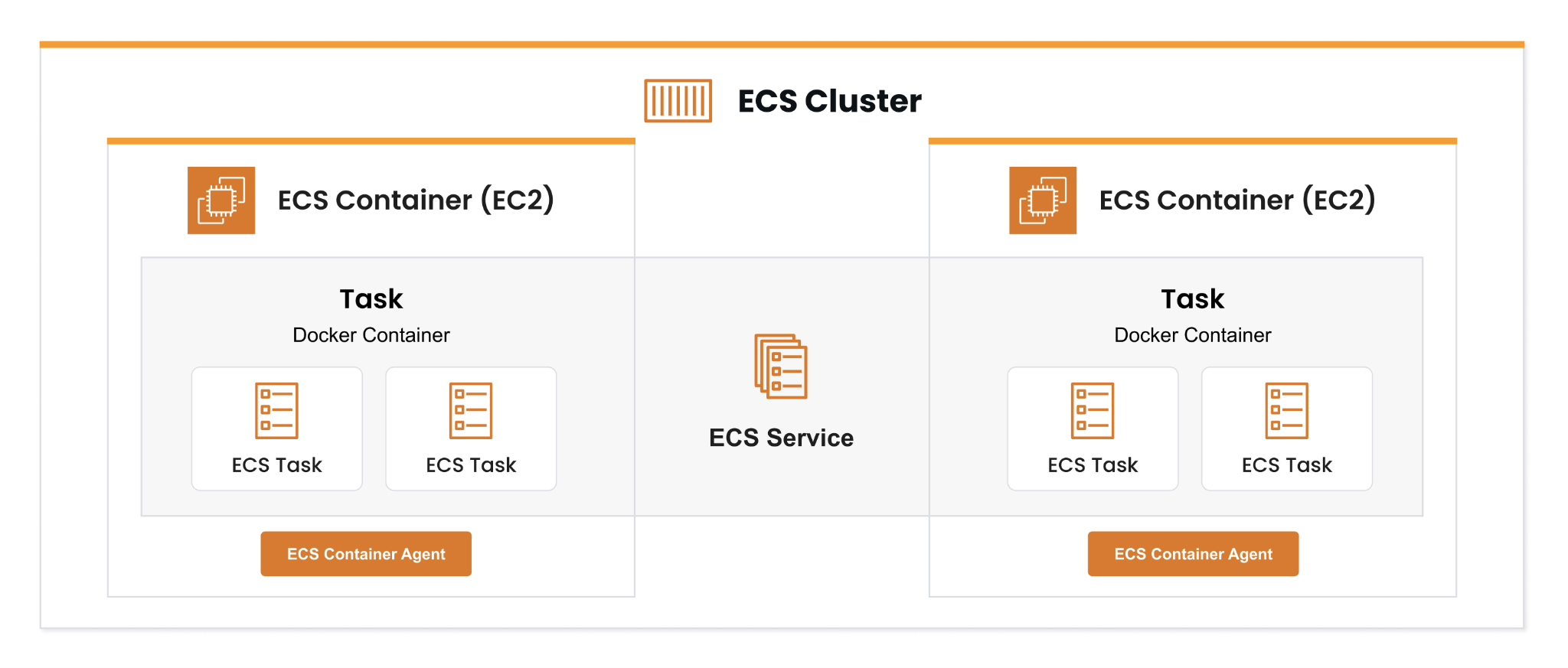
What is Amazon Elastic Kubernetes Service (EKS)?
AWS EKS brings Kubernetes, an open-source container orchestration platform, into the AWS cloud. Kubernetes offers high flexibility, a robust ecosystem and community, and a consistent open-source API which offers extensibility and portability. As a result, it is often more suited for complex applications, multi-cloud environments, and other situations which require more fine-grained control. AWS EKS abstracts away some of the complexity of managing Kubernetes, allowing users to leverage the power of Kubernetes without the operational overhead of setting up and maintaining the control plane. It also automates numerous aspects of running a Kubernetes cluster, including patching, node provisioning, and updates.
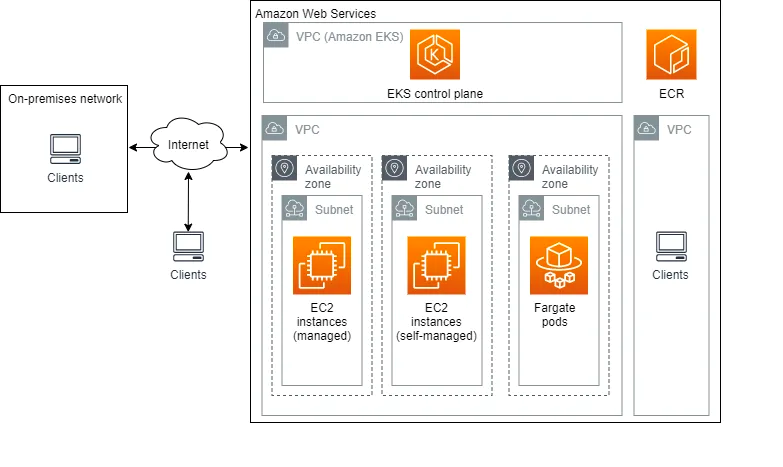
ECS vs EKS: Which Container Orchestration Service to Choose?
ECS and EKS each offer unique benefits. In sum, the basic differences are:
|
Factor |
ECS |
EKS |
|
Application Complexity |
Suited for more simple applications, tightly integrated with AWS |
Suited for more complex, microservices-oriented architectures |
|
Team Expertise |
Familiarity with AWS services |
Knowledge of Kubernetes is required |
|
Operational Overhead |
Lower |
Higher |
|
Cost |
Potentially lower with Fargate, depending on usage patterns |
Includes the cost of the control plane, potentially higher |
|
Portability |
Less portable outside AWS, less suited for hybrid/multicloud |
High portability, thanks to Kubernetes’ open standards |
|
Community Support and Ecosystem |
Benefits from strong support within the AWS ecosystem |
Has a vast and active community, with a rich ecosystem of tools and integrations |
Application Complexity, Overhead and Control
ECS is ideal for straightforward applications or those deeply integrated with AWS services. It offers a more simple approach to container orchestration with minimal operational overhead, due to its fully managed nature. It is a convenient option for quick deployments and management, particularly for teams already familiar with AWS.
So, when would you want to move to EKS if ECS is simpler? The tradeoff of simplicity is less control and flexibility. EKS is well-suited for complex, microservices-based applications. It enables more control over how and where containers (lightweight packages of software that contain all of the necessary elements to run in any environment) are placed based on custom logic or requirements, and introduces the concept of “pods,” which are the smallest deployable units that can be created, scheduled, and managed. In EKS, containers are grouped within pods for efficient resource sharing. A pod can hold multiple closely integrated containers, allowing for more complex deployment scenarios.
EKS has higher operational overhead due to Kubernetes’ complexity. It has a higher learning curve and requires a deeper understanding of Kubernetes. However, it provides more fine-grained control. In addition, the vast Kubernetes ecosystem offers a wealth of tools, extensions, and solutions.
Costs of AWS Services
AWS ECS pricing is primarily based on the underlying compute and storage resources used by the containers. The choice between EC2 and Fargate launch types significantly affects the cost (with Fargate launch type generally being cheaper). In general, AWS ECS may be cheaper than EKS and offers cost savings for applications tightly integrated with AWS.
EKS pricing includes charges for the managed Kubernetes control plane ($0.10 for each EKS cluster) in addition to the compute and storage resources used by the worker nodes. The choice between self-managed nodes and using AWS Fargate significantly influences overall costs.
However, underlying resource utilization also significantly impacts total costs. Kubernetes supports several types of autoscaling, including Horizontal Pod Autoscaler (HPA), Vertical Pod Autoscaler (VPA), and Cluster Autoscaler. It can also scale workloads based not just on system metrics like CPU and memory usage, but also on custom and external metrics, allowing for more responsive autoscaling. In addition, it has a sophisticated scheduler and resource management system, considering various factors like resource requirements, affinity/anti-affinity rules, and taints and tolerations when scheduling pods. If employed effectively, these features potentially result in more efficient use of AWS resources and thus better cost-effectiveness.
Portability & Hybrid Cloud
While AWS ECS offers tight integration with AWS services and can be easier to use within the AWS ecosystem, it’s not as portable as EKS. On the other hand, EKS is ideal for scenarios where portability across different environments is essential.
For organizations looking to maintain portability and flexibility across different environments (on-premises, AWS, other clouds), EKS ensures that applications can be easily moved due to Kubernetes’ open standards and universal portability.
Amazon ECS vs EKS Use Cases
Let’s illustrate these various differences through some quick use cases and examples:
|
Amazon ECS vs EKS: Common use cases |
||
|
Use Case |
Amazon ECS |
Amazon EKS |
|
Batch Processing |
Run your jobs on ECS if you need access to particular instance configurations (particular processors, GPUs, or architecture) or for very-large scale workloads. |
If you have chosen Kubernetes as your container orchestration technology, you can standardize your batch workloads using Batch integration with EKS. |
|
Machine Learning Workloads |
ECS can be a good fit for simpler ML workflows, especially when integrated with AWS services like SageMaker for seamless deployment and scaling within the AWS ecosystem. |
EKS may be preferred for complex ML pipelines, benefiting from the Kubernetes ecosystem and tools like Kubeflow for enhanced orchestration, scalability, and community support.
|
|
Stateful Applications |
ECS with AWS Fargate can simplify running stateful applications by managing the underlying infrastructure, although it may require additional services like EFS for persistent storage. |
EKS supports stateful applications natively with StatefulSets, providing more control over storage and state management, making it easier to scale and manage complex stateful services via the AWS Management Console or CLI.
|
|
CI/CD Pipelines |
ECS can be integrated with other AWS services like CodePipeline and CodeBuild for a smooth CI/CD experience within AWS, suitable for straightforward deployment pipelines. |
EKS offers flexibility in setting up more complex CI/CD workflows, leveraging a broad range of integrations with Kubernetes-native and third-party CI/CD tools, providing more customization options. |
|
Security |
Provides IAM roles for tasks, VPC integration, and security group assignments to containers, offering a solid security foundation with the simplicity of AWS service integration. |
Brings Kubernetes’ RBAC (Role-Based Access Control) to the table, offering fine-grained access control over resources in the Kubernetes cluster. It also integrates with AWS IAM and supports IPv6 support, service discovery via AWS Cloud Map, servish mesh via AWS App Mesh, etc. |
AWS Fargate
Now, let’s add another complication into the mix: should you use Fargate or EC2 with your container orchestration service?
What is AWS Fargate?
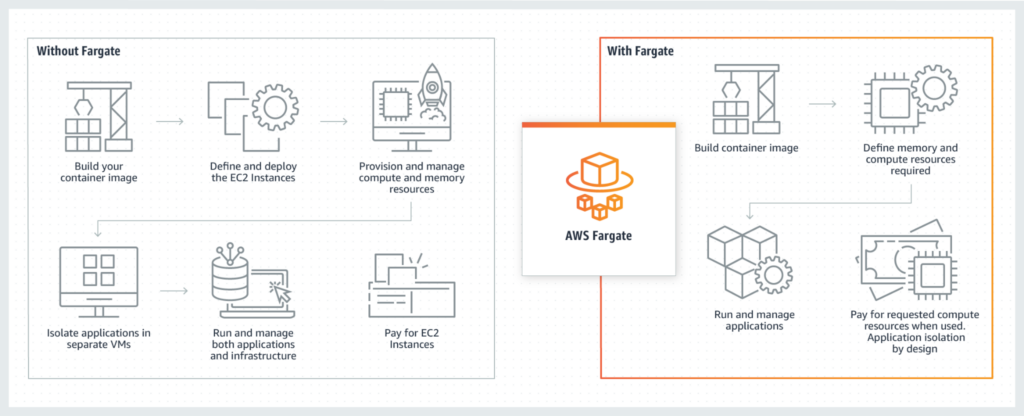
AWS Fargate is a serverless compute engine for containers that removes the need to manage servers or clusters. It allows users to run containers directly, without having to handle the underlying server infrastructure. Fargate allocates the right amount of compute, eliminating the need to select EC2 types, decide when to scale your clusters, or optimize cluster packing.
The crux is that this simplifies the running of your applications, but you have less control.
Fargate integrates with both ECS and EKS, providing flexible options for deploying containerized applications.
EC2 vs Fargate with ECS/EKS
Earlier, we said that the primary decision isn’t ECS vs EKS vs Fargate, but rather: (1) ECS vs EKS for your container management service, and (2) EC2 vs Fargate for hosting your containers. There is no significant distinction to be made on the question of ECS with Fargate or EKS with Fargate; it is simply a question of whether you opt for Fargate or EC2 in conjunction with your chosen container service.
When deciding between Amazon EC2 and AWS Fargate, the choice hinges on specific requirements and control levels. EC2 is preferable if:
- You need control over the server environment, including OS, patches, and instance types tailored to workload demands (essential for legacy applications needing particular configurations)
- You need granular control over scaling at the instance level for performance optimization
- You have and accommodates custom hardware needs like specific CPU/memory setups or GPU usage for intensive computations
- Your applications have precise network and security compliance requirements, demanding direct access to the host machine for enhanced monitoring or compliance controls
- Your workloads are stable and predictable, allowing cost efficiency to be achieved through reserved instances
Conversely, Fargate is more suited when:
- Your existing workloads are already running on modern serverless technologies
- You don’t want or need to worry about scaling and managing instances (selecting server types, deciding when to scale, managing security patches, etc.)
- Workloads are event-driven and sporadic (Fargate scales automatically and you pay only for computing time, not underlying EC2 instances)
- Your applications can run in a stateless matter (Fargate does not support persistent local storage after the the container is stopped)
- You need quick deployment cycles, such as for testing and deploying applications
- You are running microservices architecture (it allows each service to be packaged into its container, scaled independently and managed centrally).
Fargate Use Cases
Let’s illustrate these differences with some specific real world examples.
|
Use Case |
EC2 |
Fargate |
|
Machine Learning Model Training |
Ideal for machine learning tasks that require custom GPU instances to speed up training processes. |
Not suitable for GPU-based tasks; better for lightweight, CPU-based model inferencing. |
|
High-Performance Computing (HPC) |
Essential for HPC applications needing custom compute types, high throughput, and low-latency networking. |
Not a good fit due to lack of specialized instance control and hardware options. |
|
Batch Processing Jobs |
Optimal for long-running batch jobs that can be cost-optimized with reserved instances or spot instances. |
Ideal for sporadic batch jobs that require quick scalability and can benefit from being stateless. |
|
Video Encoding Services |
Better for services requiring specific hardware accelerators or large amounts of storage for processing large video files. |
Suitable for smaller-scale or less frequent video processing tasks that do not require specialized hardware. |
|
Database Servers |
Preferred when hosting large databases that benefit from persistent storage and specific I/O optimization. |
Less ideal due to lack of persistent local storage and limited I/O capabilities. |
|
Microservices Architecture |
Useful for microservices that require very specific security or compliance configurations at the instance level. |
Best for microservices that need quick scaling and minimal management overhead, especially when traffic is variable. |
|
Development and Testing Environments |
Advantageous for development environments needing specific configurations that mirror production closely. |
Convenient for testing environments due to ease of setup and teardown, helping to reduce costs and overhead. |
|
Multi-Tenancy Applications |
Necessary when applications need isolated environments at the hardware level to ensure security and compliance. |
Appropriate for simpler multi-tenancy applications where container isolation provided by Fargate suffices. |
|
Regulated Workloads (e.g., Healthcare, Finance) |
Often required for workloads that must comply with stringent regulatory requirements for data handling and processing. |
Possible to use if compliance can be ensured at the container and network level without specific hardware control. |
|
Event-Driven, Sporadic Workloads |
Less ideal due to potential resource underutilization and higher costs. |
Highly effective as it allows for precise scaling and billing in response to events, minimizing costs. |
Container Management is Better with nOps Compute Copilot
Are you already running containers and looking to automate your workloads at the lowest costs and highest reliability?
nOps Compute Copilot helps companies automatically optimize any compute-based workload. It intelligently provisions all of your compute, integrating with your ECS or EKS workloads to automatically select the best blend of SP, RI and Spot. Our mission is to make it faster and easier for engineers to optimize, so they can focus on building and innovating.
With nOps, you get:
Detailed Insights Into Your Container Costs
Achieve precise cost allocation at the container level with nOps. nOps automatically and continuously analyzes your Kubernetes clusters and AWS CUR data to map your costs with complete accuracy, and link them back to the individual business units producing them.
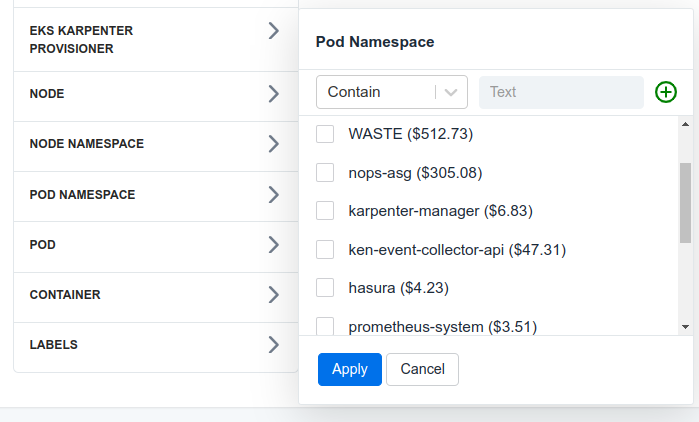
- See the hourly costs associated with each container, pod, and service within your clusters and easily identify waste
- See your true costs with commitments applied to your hourly usage, sliced by any relevant dimension (workload, environment, resource type, team, pricing type…)
- Allocate service delivery costs by customer, product or feature with showbacks, making it easy for product, finance and engineering teams to budget, forecast, and track costs
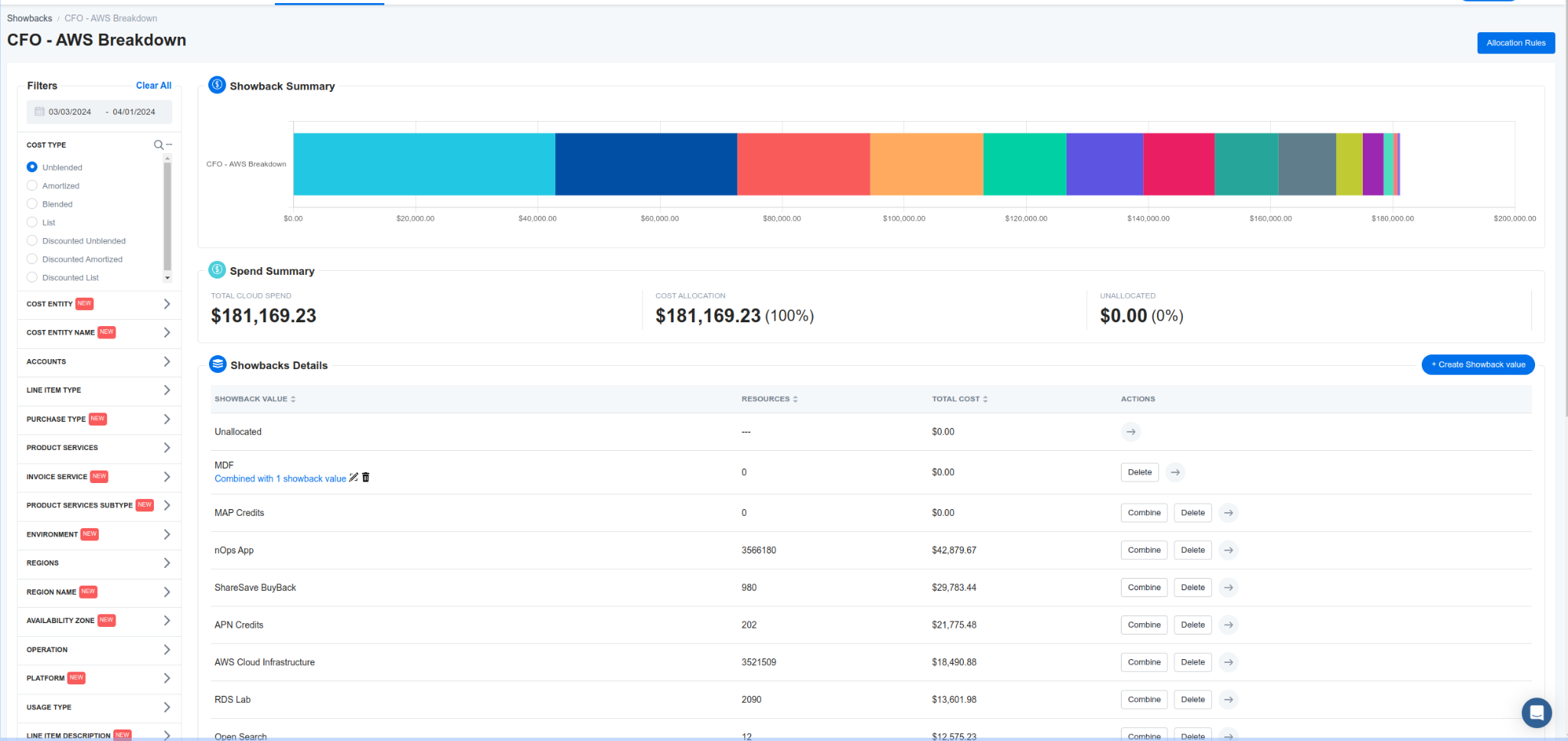
Effortless Spot Savings
Copilot empowers you to run many more workloads safely on Spot, for greater savings and less manual effort. We analyze massive amounts of proprietary Spot market and historical data with ML to predict how long Spot instances will live. With 60-minutes advance termination warning, Copilot continually and proactively moves your workloads onto diverse instance types leveraging Karpenter, gracefully draining nodes so that Spot interruptions don’t have any effect on your workload. nOps automatically generates the widest possible list of instance families suited to your workload, such that there are always cheap and reliable instances available to move you into, allowing us to offer the same reliability SLAs as AWS On-Demand.
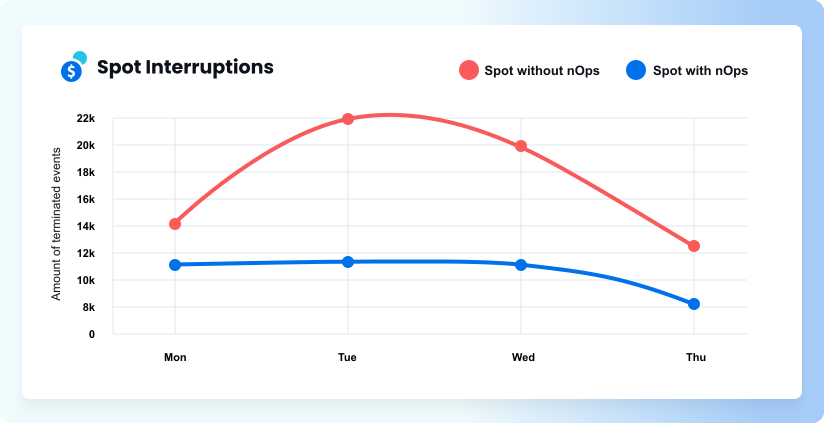
Guided Karpenter Configuration and Continuous Tuning
Optimal configuration of Karpenter is strongly interlinked with the state of the compute in the cluster as well as outside factors such as Spot availability or utilization of existing commitments. Clusters scale, Spot availability changes and commitments become overutilized or underutilized. As a result, Karpenter configurations need to be continuously revisited to ensure that they are optimal. A primary goal of Compute Copilot for Karpenter is to automate the process of review and reconfiguration of Karpenter, with full awareness of your RI, SP, and the Spot market. Automation allows Copilot to tune Karpenter much more frequently than a human maintainer would, translating to better results and many hours of work saved.



